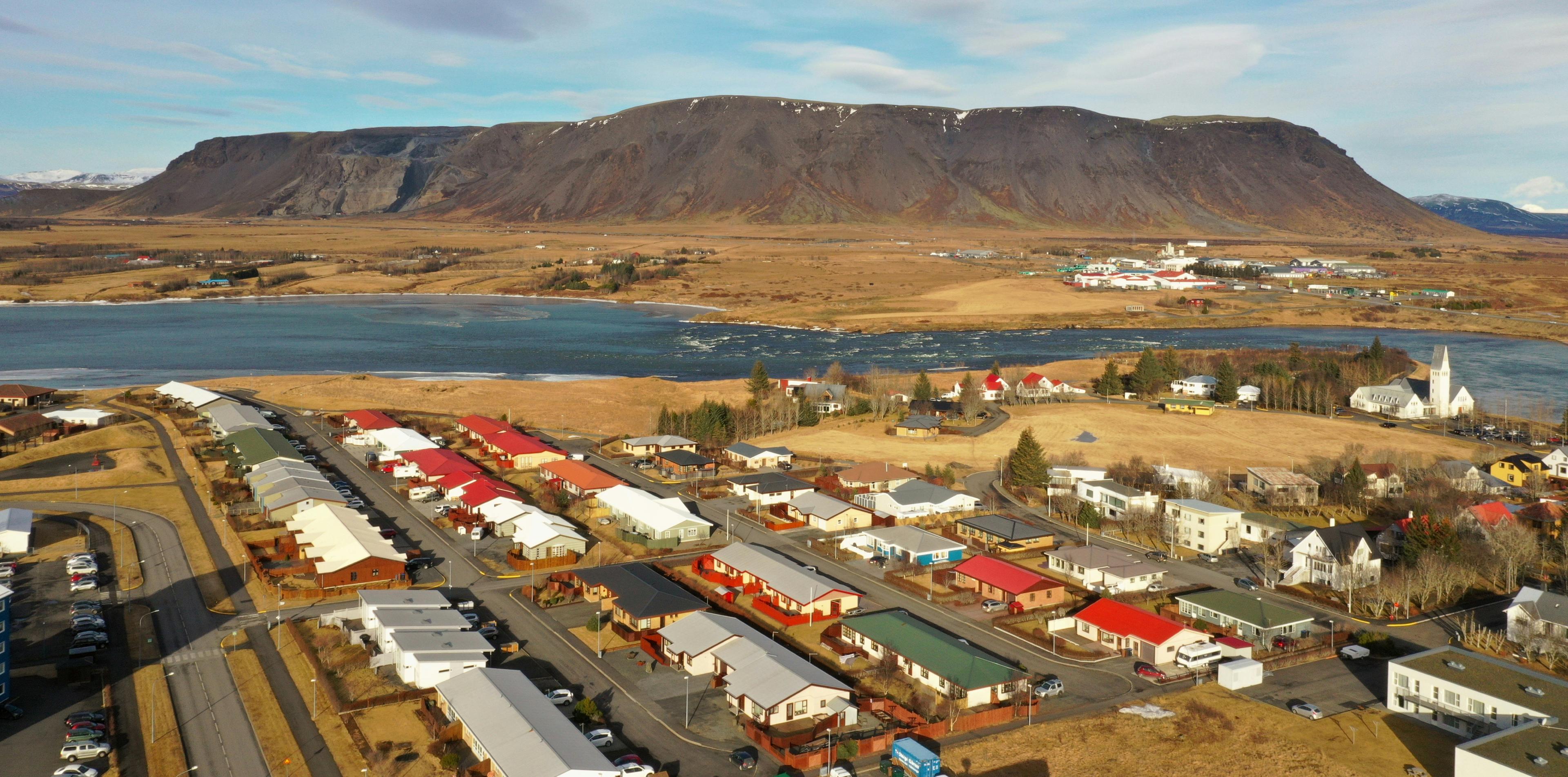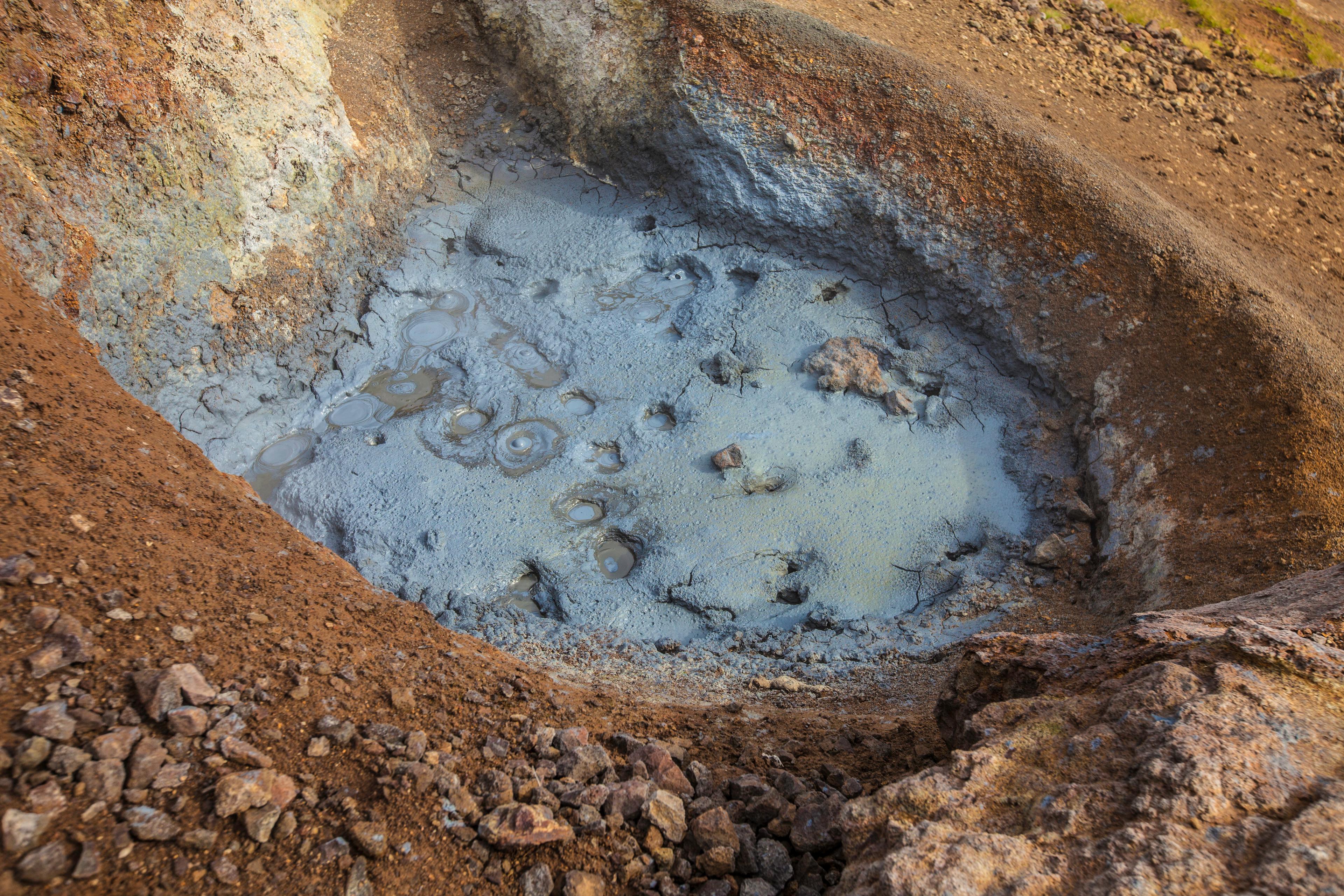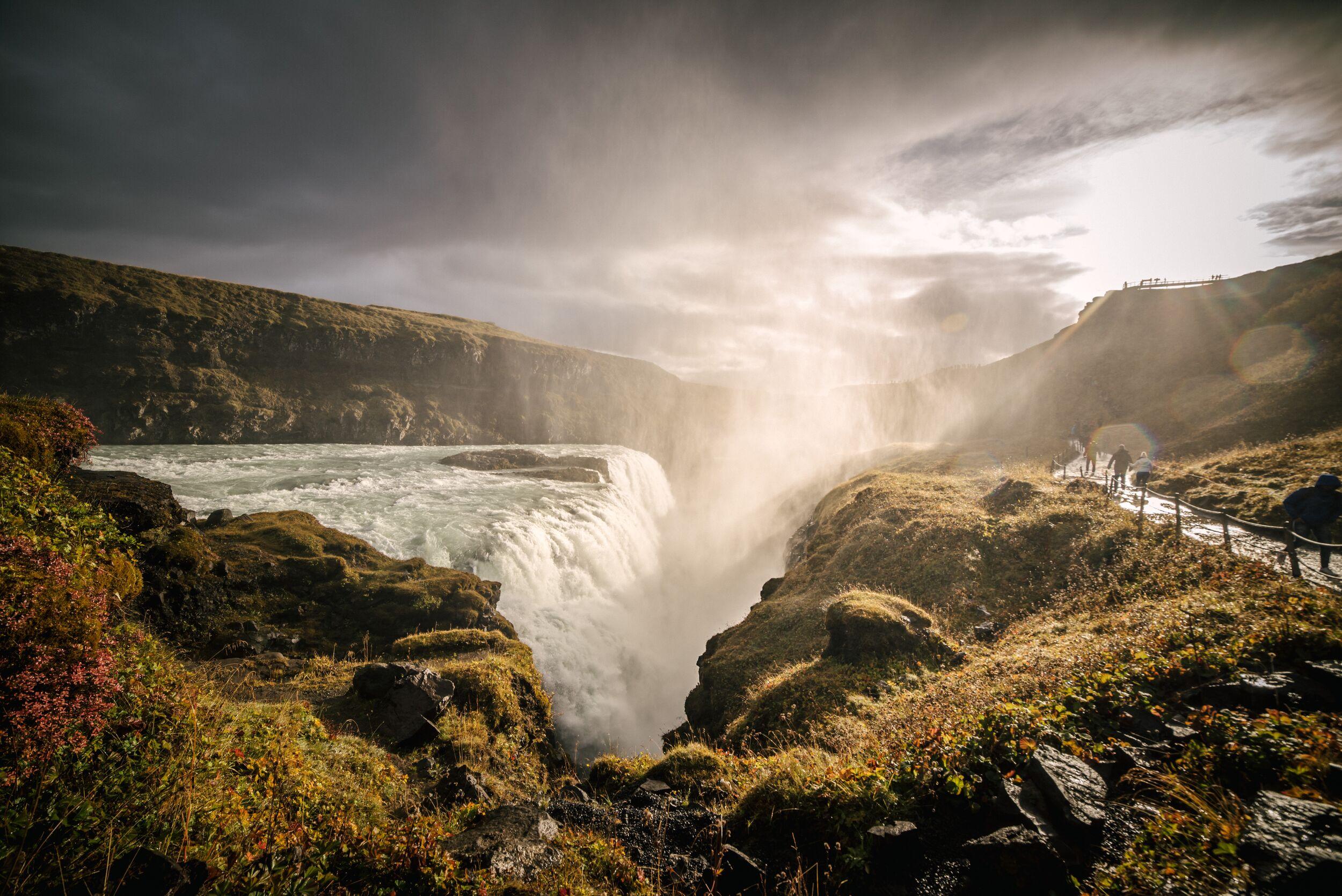
- Best time to visit
- All year-round
- Coordinates
- 63.99953, -21.17976
- Distance from Reykjavík
- 45km (28mi)
Welcome to Hveragerði, Iceland’s “Geothermal Town”
Why visit Hveragerði?
Hveragerði is a small village in the south of Iceland. While many people might drive straight past it towards the more famous sights along the south coast, there are many good reasons to stop here. In fact, it’s a contender for the most fascinating settlement in the area.
Hveragerði often goes by the nickname, “The Geothermal Town”, which in a country like Iceland is saying quite a lot. It’s one of the few settlements in the world that’s actually built on a geothermal field. Here, hot springs and fumaroles pop up in the middle of the village, and most of the town gets its energy directly from the volcanic activity below the surface of the earth.
The first place to see this in action is the Geothermal Park Hveragerði. It’s an historic area of hot springs literally right in the centre of the village. Visit to see the breathtaking elements of volcanic activity—fumaroles, steam vents, and more—present amongst the everyday lives of local Icelanders. You can even take the opportunity to boil an egg in the naturally heated waters.
Outside of the village, most people come to the area to visit Reykjadalur, the so-called “steam valley”. Here, natural geothermal energy heats a river that flows through the valley. It’s so warm, in fact, that you can bathe in it all through the year, even when there’s snow on the ground. It’s a great place to unwind—and to see the northern lights in winter.
The valley is a short hike outside of Hveragerði. You’ll pass through the valley itself before reaching the various pools. There are some minimal changing rooms in the valley so that you can kick off your hiking boots and change into your swimsuit before taking a dip in the warm water. Where else can you say that you’ve bathed in a heated river?
There are many more things to see and do too. For example, why not visit Sundlaugin Laugarskarði, which was once the largest swimming pool in Iceland? With steam baths and a sauna, it’s another asset powered by geothermal energy. Follow it up with a beer at Ölverk, a local brewery that runs on geothermal power.
Finally, you shouldn’t miss the greenhouses that can be found throughout the area. Hveragerði likely has the highest concentration of greenhouses in Iceland, all heated by geothermal power. You can find some surprising crops in Iceland’s rugged landscape, including tropical fruit such as papayas and bananas!
How to get to Hveragerði
Hveragerði is located on route 1, Iceland’s iconic “ring road” that loops the entire island. As such, it’s really conveniently located, wherever you might be coming from.
If you’re travelling from Reykjavík, Hveragerði is about 45 minutes away by car. As you leave the capital, join route 1 and head east along the south coast. After about 45 kilometres (28 miles), you’ll reach the village, just before the larger town of Selfoss.
Alternatively, if you’re journeying from the east, head along route 1 until Selfoss, the largest town in South Iceland. Continue on route 1 and you’ll reach Hveragerði after about 15 minutes.
Many visitors won’t want to drive, however. Iceland is known for its volatile weather, particularly in winter, when roads can quickly become icy and storms can descend very quickly. As a result, many people prefer to do their sightseeing with a guided tour or local bus.
For example, you can visit the Reykjadalur valley on a day tour from Reykjavík. We’ll pick you up at your hotel downtown and handle all the transport. We’ll visit the greenhouses at Hveragerði and hike up to the steam valley.
Just remember, however you visit Hveragerði village, you can only visit Reykjadalur on foot. The journey from the village is about 3 kilometres (1.8 miles) and you can expect to reach the springs in about 45 minutes. Just make sure you bring some sturdy shoes and clothes suitable for the weather. The path isn’t too difficult, but it isn’t paved, so appropriate footwear is a must.
Other sights in the area
Hveragerði is at the centre of one of the most fascinating areas in Iceland. If you’re visiting or staying in the area, there’s so much more to see and do.
For instance, don’t miss the Golden Circle, probably Iceland’s most famous travel itinerary. Hveragerði is only a short distance away from the likes of Gullfoss waterfall, Geysir, and the breathtaking Þingvellir National Park. In fact, choose a guided tour that takes you to all three sights alongside Reykjadalur.
Hveragerði is a great place from which to explore the length of the south coast of Iceland too. For example, head east towards the village of Vík, explore the glaciers and volcanoes around Eyjafjallajökull, or go hiking in the pristine valley of Þórsmörk.
Alternatively, travel west towards the Reykjanes peninsula. This is one of the youngest areas of land in Iceland, thanks to the area’s volcanic activity. With live volcanoes, geothermal pools, and plenty more, it offers another perspective on the Land of Ice and Fire.
Whichever you choose to visit, at Icelandia we can make it easy. Explore our tours for more information.
Frequently asked questions
Hveragerði is home to the Ölverk brewery, which opened in 2017. The brewery—which has an onsite bar and pizza restaurant—is known for using geothermal energy to power its operations. It’s an approach to beer-making that you won’t really find anywhere else!
The Hveragerði geothermal park is open all year round, including the winter. You’ll find it in the centre of the village of Hveragerði.
You can also visit Reykjadalur hot springs—just outside Hveragerði—all year round too. If you’re visiting in winter, make sure that you have sturdy shoes and take the local weather conditions into account. If it is stormy, for example, it might not be the best time to visit.
The Hveragerði geothermal park is right in the centre of the village of Hveragerði. This is one of the few villages in the world that is built literally directly on top of a geothermal vent.
You’ll find the village of Hveragerði on route 1, Iceland’s “ring road”. It’s about 45 kilometres (28 miles) to the east of Reykjavík, just before you arrive in the town of Selfoss.
Iceland is one of the best countries in the world to see the northern lights, thanks to its northern location and its very sparse population. Whenever you have a clear sky, these are the perfect conditions to see the aurora borealis.
Hveragerði is as good as any town in Iceland to witness them. For example, hike up to Reykjadalur, the “steam valley”, to get away from the lights and see them even better.
The village of Hveragerði actually has the highest concentration of greenhouses in Iceland.
It’s a really important agricultural area, but what makes the village particularly special is the way that locals harness geothermal energy to provide the right conditions for their crops. For example, even bananas and papayas are grown here thanks to the geothermal energy.
They are definitely worth a visit for the incredible insight into Iceland’s agricultural history and innovative methods.
Hveragerði is home to what was once the largest swimming pool in the country, the Sundlaugin Laugaskarði. It’s a beautiful pool in a scenic location, with a sauna and a natural steam bath.
The name Hveragerði can be a little tricky for visitors to pronounce, as there are some letters there that might catch you by surprise!
Firstly, the letters “hv” are pronounced with a hard “k” sound. You’ll say this as “kv”. Then there’s the letter ð, which may be unfamiliar to you. It’s pronounced like the English “th” sound.
So, put that together and you have something like kver-a-ger-thi. Don’t worry if you don’t get it totally right though—you’ll be understood!
Hveragerði is in an area of powerful geothermal activity. There are many incredible things to see that are caused by this local volcanism:
- Visit the Geothermal Park Hveragerði, an historic area of hot springs, where you can see fumaroles and more.
- Hike to Reykjadalur, where you can bathe in the warm river heated naturally by geothermal energy.
- Take a dip in the Sundlaugin Laugaskarði swimming pool, where you can enjoy a sauna powered by local volcanoes.
Hveragerði is best known for its powerful volcanic activity. In fact, it’s often referred to as “the Geothermal Town” because of the many hot springs in the surrounding area.
For example, there’s a geothermal park in the centre of the town, with hot springs and fumaroles, where steam rises out of the ground. And, close by, you’ll find Reykjadalur, the famous “steam valley”, with its warm river.
Hiking boots are definitely recommended for the hike from Hveragerði to the Reykjadalur valley. The walk takes most people less than an hour, but it does involve some ascent and it is not paved. That means some sturdy shoes are a good idea.
You can visit Hveragerði at any time of the year. The sights that are available in the village are not strictly weather-dependent and will be open in all seasons. So, make sure you visit, whenever it is you’re coming to Iceland.
All we’d say is that you should be prepared for the season in which you’re visiting. That means if you’re in the area in winter, make sure you’re prepared for the cold.
You do have to pay a fee if you visit the car park at the start of the path to Reykjadalur. It costs 200 ISK for the first hour, and then 250 ISK for every hour after that.
The parking is free if you stay for no more than 15 minutes. However, you won’t be able to reach Reykjadalur valley in that time.
Iceland has a reputation for being quite expensive and Hveragerði is no exception. However, there are lots of budget accommodation and eating options available. In Hveragerði, for example, there is a campsite that offers quality accommodation for those on a budget.
The only way to reach the thermal river of Reykjadalur is on foot. From the carpark on the outskirts of Hveragerði, the valley of Reykjadalur is 3 kilometres (1.8 miles) and typically takes 45 minutes to an hour, one way.
It’s not a difficult walk. But it is worth being prepared for some elevation gain and some unstable terrain. Sturdy shoes are a must.





